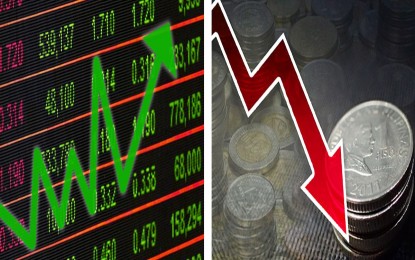[7.19] PH, 2025년까지 상위 중산층 지위 달성
컨텐츠 정보
- 20,212 조회
본문
마닐라 – 필리핀은 2025년까지 중상위 소득 국가가 될 것이라고 NEDA(National Economic and Development Authority) 장관 Arsenio Balisacan이 수요일에 말했습니다.
발리사칸은 브리핑에서 "우리는 순조롭게 진행되고 있으며 2023년과 2024년 성장 전망에 대한 현재 가정을 바탕으로 2025년에 중상위 소득 국가 지위를 달성할 것"이라고 말했다.
세계은행 자료에 따르면 필리핀은 현재 2022년 기준 1인당 국민총소득 3,950달러로 중저소득 국가로 분류된다.
발리사칸은 "상위 중산층에 합류하기 위한 문턱은 미화 4,500달러 또는 그 정도에 가깝다"고 말했다.
그는 필리핀이 "2020년 경제의 급격한 위축이 아니었다면 지금쯤은 사실상 중산층이 되었을 것"이라고 인정했다.
코로나바이러스 질병 2019(Covid-19)의 확산을 막기 위해 부과된 엄격한 검역 조치로 인해 2020년 필리핀 경제는 9% 이상 위축되었습니다.
발리사칸은 "수축으로 인해 3년을 잃었다"고 말했다.
그러나 Balisacan은 국가의 성장 전망에 대해 낙관적이라고 말했습니다.
그는 정부가 올해 6~7%의 경제 성장 목표를 유지하고 있으며 이 목표의 하단을 달성하려면 향후 3분기 동안 경제가 최소 5.9% 성장해야 한다고 덧붙였습니다.
그는 "따라서 우리가 하단에 도달하더라도 다른 모든 곳이 다운그레이드이고 외부 환경이 크게 개선되지 않았다는 점을 감안할 때 여전히 놀라운 성능이라고 생각한다"고 덧붙였다.
한편 Balisacan은 Maharlika 투자 기금(MIF)과 민관 파트너십(PPP)이 필리핀이 중상위 소득 국가로 전환함에 따라 개발 프로그램과 프로젝트를 지속하고 완료하는 데 도움이 될 것이라고 말했습니다.
그는 한국이 상위 중산층 지위를 달성하면 더 이상 공적개발원조(ODA)와 같은 양허성 차관을 받을 자격이 없을 것이라고 말했습니다.
양허성 대출은 중상위 소득 국가에 낮은 이자율과 연장된 유예 기간을 제공합니다.
"이 시점에서 우리는 이미 그러한 만일의 사태에 대비하고 있습니다. 하나는 PPP의 거버넌스를 더욱 견고하게 하여 ODA로 자금을 조달할 수 없는 경우 PPP가 자금을 지원하는 인프라와 같은 주요 프로젝트를 가질 수 있도록 하는 것입니다."라고 그는 덧붙였습니다.
Balisacan은 MIF 이니셔티브가 중요한 프로젝트나 사회적 프로젝트에 자금을 지원하는 데에도 사용될 수 있다고 말했습니다.
"그러나 저소득 국가에 남아있는 것과 양허성 대출에 대한 접근을 유지하는 것 사이에서 나는 중상위 소득 국가를 택할 것입니다. 왜냐하면 그것은 특히 양질의 일자리 창출과 빈곤 감소와 함께 오는 경우 모든 필리핀인에게 더 높은 생활 수준을 의미하기 때문입니다."(PNA)라고 그는 말했습니다.
This is the Oriignal Article from PNA NEWS
[7.19] PH to achieve upper middle-income status by 2025
MANILA – The Philippines is on track to be an upper middle-income country by 2025, National Economic and Development Authority (NEDA) Secretary Arsenio Balisacan said on Wednesday.
"We are on track and the upper middle-income country status will be achieved in 2025 based on our estimates given current assumptions on our growth prospects for 2023 and 2024. [I'm] hoping that we don't have any major disasters or external factors that will hit us again," Balisacan said in a briefing.
Based on the World Bank's data, the Philippines is currently classified as a lower middle-income country with a gross national income per capita of USD3,950 as of 2022.
"The threshold [for] joining upper middle-income class is something like USD4,500 or something close to that," Balisacan said.
He admitted that the Philippines "should have been by now actually an upper middle-income class if not for the sharp contraction of the economy in 2020."
The strict quarantine measures imposed to prevent the spread of coronavirus disease 2019 (Covid-19) caused the Philippine economy to contract by more than 9 percent in 2020.
"We lost three years as a result of the contraction," Balisacan said.
However, Balisacan said they are optimistic about the country's growth prospects.
He said the government is keeping the 6 to 7 percent economic growth target for this year, adding the economy should grow by at least 5.9 percent in the next three quarters to achieve the lower end of this target.
"So if we hit the lower end, I think that is still a remarkable performance given that everywhere else is a downgrade and the external environment has not much improved," he added.
Meanwhile, Balisacan said the Maharlika Investment Fund (MIF) and the public-private partnership (PPP) will help the Philippines to sustain and complete its development programs and projects as it transitions to upper middle-income country.
He said that once the country achieves an upper middle-income status, the country will no longer be qualified for concessional loans like official development assistance (ODA).
Concessional loans offer low interest rates and extended grace periods to countries with below upper middle income status.
"At this point, we are already preparing for that eventuality. One is getting the governance of PPP more robust so that we can have those key projects like infrastructure funded by PPP if we can't fund them by ODA," he added.
Balisacan said the MIF initiative could also be used to fund critical or social projects.
“But between the choice of remaining (in) a lower income country and keeping your access to concessional loans, I would rather go for (an) upper middle-income country because that means higher standard of living for all Filipinos especially if it comes with generation of high quality jobs and reduction in poverty," he said. (PNA)
관련자료
-
이전
-
다음


